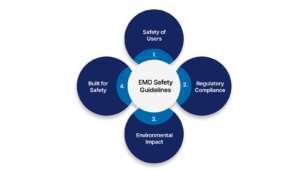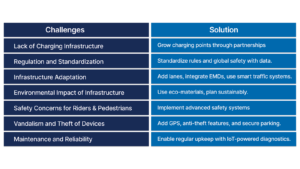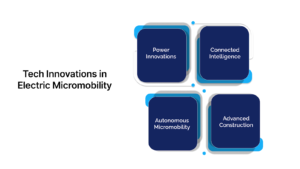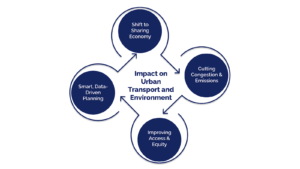 AllMicro Mobility Model
AllMicro Mobility Model
Understanding Micromobility Devices and Their Impact
In 2025, the global micro-mobility market is projected to reach USD 75.85 billion, growing at a compound annual growth rate (CAGR) of 20.4%. This rapid growth highlights a larger shift in urban transportation, where micro mobility devices are playing a central role. These compact, lightweight vehicles, ranging from electric scooters and e-bikes to electric skateboards and pedal-assist tricycles, are revolutionizing how we travel short distances within city environments.
In this blog, we will explore what these devices are and examine their profound effects on urban life and infrastructure.
What Is Electric Micromobility?
Electric micromobility refers to small, efficient, and eco-friendly transportation options like e-bikes, e-scooters, and other lightweight electric vehicles—perfect for short-distance travel and reducing your carbon footprint.
These devices are usually charged through standard 120V AC residential outlets. The time required for charging can vary from 2.5 to 9 hours, depending on the battery capacity of the device and the specifications of the charger, whether it’s a cable or a docking system.
Now, let’s take a closer look at the various types of electric micro mobility devices (EMDs) and how they are customized to meet the needs of different riders and environments.
Types of Micro Mobility Devices
Electric micro mobility devices come in various forms, each designed to meet specific transportation needs. Here are some of the most common types:
1. E-Bikes
Electric bicycles, or e-bikes, are categorized based on their motor assistance and speed capabilities. Understanding these classifications is essential for compliance with local regulations and for selecting the right e-bike for specific needs. Let’s take a closer look at the different types of e-bikes, categorized by their motor assistance:
Class 1 E-Bikes
- Motor Assistance: Pedal-assist only; the motor engages only when the rider is pedaling.
- Maximum Speed: Assists up to 20 mph (32 km/h).
- Legal Status: Generally permitted on bike paths and multi-use paths, subject to local laws.
- Ideal Use: Commuting and recreational rides on flat terrains.
Class 2 E-Bikes
- Motor Assistance: Throttle-assisted; the motor can propel the bike without pedaling.
- Maximum Speed: Assists up to 20 mph (32 km/h).
- Legal Status: Allowed on bike paths and multi-use paths in many regions.
- Ideal Use: Short-distance commuting and casual rides.
Class 3 E-Bikes
- Motor Assistance: Pedal-assist only; the motor engages only when pedaling.
- Maximum Speed: Assists up to 28 mph (45 km/h).
- Legal Status: Restrictions vary; often allowed on roads but not on bike paths or multi-use paths.
- Ideal Use: Long-distance commuting and faster travel on roads.
Regulations surrounding these e-bikes can vary significantly by country and region. For example, in the United States, the Consumer Product Safety Commission defines e-bikes as bicycles equipped with fully operable pedals and an electric motor of no more than 750 watts (1 horsepower).
2. E-Scooters
Electric scooters are compact, motorized vehicles designed for short-distance travel. It is equipped with handlebars and a floorboard, providing stability for the rider. The handlebars are used for steering, while the floorboard serves as a platform for standing. Below are some of their key features:
- Throttle Operation: Most e-scooters come with a throttle to control speed. Riders can accelerate by twisting or pressing the throttle. Some models may require the rider to give a small kick to start the motor, a feature known as “kick-to-start.”
- Motor Power: Typically ranges from 250W to 750W.
- Speed: Most models have a top speed between 15 mph (24 km/h) and 20 mph (32 km/h).
- Range: Varies from 10 to 40 miles (16 to 64 km) per charge, depending on battery capacity and terrain.
- Weight: Generally lightweight, ranging from 20 to 40 lbs (9 to 18 kg), facilitating portability.
Operational Guidelines
- Helmet Use: Recommended for all riders; mandatory in some regions.
- Age Restrictions: In many states, the minimum age for riders is set at 16.
- Riding Areas: Allowed on roads, bike lanes, and multi-use paths; sidewalk riding is often prohibited.
- Speed Limits: Vary by jurisdiction; typically between 15 mph (24 km/h) and 20 mph (32 km/h).
- Safety Equipment: Must be equipped with front and rear lights, reflectors, and a bell or horn for signaling.
3. Electric Mopeds
Some e-scooter models feature pedals, classifying them as mopeds, while others lack them and are classified as motorcycles. E-mopeds bridge the gap between e-bikes and e-motorcycles, offering more robust features and making them ideal for longer commutes. Here are some of their key features:
- Motor Power: Typically ranges from 500W to 2000W.
- Speed: Can reach speeds up to 28 mph (45 km/h) or higher.
- Battery: Larger capacity batteries offer an extended range compared to e-bikes and e-scooters.
Regulations vary significantly by region, typically including speed limits, helmet requirements, and age restrictions. In the U.S., for example, e-mopeds may be subject to different laws than e-bikes and e-scooters, often requiring registration, insurance, and a valid driver’s license.
4. Hoverboards
Hoverboards are self-balancing electric scooters without handlebars, controlled by shifting body weight. They are popular for short-distance urban travel and recreational use. Key features include:
- Motor Power: Typically between 200W and 400W per motor, with most models having dual motors.
- Speed: Usually ranges from 6 mph (10 km/h) to 12 mph (19 km/h).
- Range: Approximately 6 to 12 miles (10 to 19 km) per charge.
- Weight: Compact and lightweight, generally under 30 lbs (14 kg).
Get complete control over your fleet’s operations with Eazy Ride’s Admin Dashboard, a powerful tool that simplifies real-time management of vehicles, rides, and staff.
While EMDs offer innovative transportation solutions, ensuring their safety and compliance with local regulations is vital for their successful integration into city infrastructures.
What Safety Measures and Regulations Apply to EMDs?
The introduction of EMDs into urban spaces brings convenience and efficiency, but it also poses new challenges regarding user safety, infrastructure, and the environment. Here are key factors to consider:
1. Safety of Users
- Helmet Usage: Many jurisdictions require the use of helmets for riders of electric scooters or bikes. Helmet laws vary by region, but their role in reducing head injuries is universally acknowledged.
- Speed Limits: EMDs can reach speeds that may pose a risk to riders and pedestrians. Regulatory bodies in some cities have set speed limits for these devices to enhance safety.
- Rider Training: Some regions require basic training or educational programs to teach riders about safe operating practices, including proper handling and navigating traffic.
- Device Safety Standards: Devices should meet safety standards such as UL certification for batteries and compliance with local traffic laws to ensure both user safety and regulatory adherence.
2. Lithium-Ion Battery Risks and Necessary Precautions
- Battery Safety Concerns: Lithium-ion batteries, commonly used in electric micro mobility devices, can pose significant safety risks, including overheating, fires, or explosions if not properly handled.
- Rider Responsibility and Battery Disposal: Riders must follow safety guidelines for charging and storing their devices to prevent accidents.
3. Regulatory Compliance
- Vehicle Standards: Electric micro mobility devices are subject to various vehicle standards, including safety features, maximum power output, and specific components such as lighting and braking systems.
- Urban Regulations: Local governments often create specific regulations governing where and when EMDs can be used. This includes restrictions on sidewalk usage, parking zones, and no-ride areas, all intended to reduce accidents and conflicts with pedestrians.
- Insurance Requirements: In some cases, operators and users may need to have insurance coverage for liability, ensuring that accidents or damages are appropriately addressed.
4. Environmental Impact
- Emissions: Although EMDs are considered more environmentally friendly compared to traditional vehicles, the production and disposal of batteries can have a significant environmental impact. Regulations around battery recycling and disposal are essential to minimizing this impact.
- Noise and Air Pollution: While EMDs contribute to less air pollution, the potential for noise in urban areas could become a concern, particularly as the fleet of EMDs grows.
5. Infrastructure and Safety Features
- Dedicated Lanes: Safe infrastructure, such as dedicated bike lanes or scooter lanes, is a key component of ensuring rider safety. Many cities are investing in these features to accommodate the growing number of electric micromobility users.
- Smart Features: Many electric devices are now equipped with smart safety features such as automatic speed regulation, GPS tracking, and geofencing to ensure riders are within safe zones.
Having addressed the safety and regulatory aspects, let’s examine the practical challenges cities face when attempting to integrate electric micro mobility devices into their urban spaces.
Key Challenges and Solutions in Integrating Micromobility Devices
As electric micromobility devices become more prevalent, several challenges must be addressed to ensure seamless integration into urban environments. Below are key obstacles and corresponding solutions that can help drive their widespread adoption:
By addressing these challenges with thoughtful solutions, cities can create a user-friendly urban transportation ecosystem. Let’s explore how technological advancements and innovations are shaping the future of electric micromobility.
Tech Innovations in Electric Micromobility
Electric micromobility devices are experiencing rapid advancements, driven by technological innovations that enhance their efficiency, accessibility, and sustainability. Below are several key technological opportunities and innovations within this sector:
1. Battery and Charging Advancements
- Longer Battery Life: Improvements in battery technology, such as lithium-ion advancements, solid-state batteries, and the development of ultra-fast charging solutions.
- Wireless Charging: Exploring the possibilities of inductive charging systems and their integration into urban spaces, reducing the need for manual charging.
2. Smart Features and IoT Integration
- Connected Devices: Real-time data collection through IoT enhances performance monitoring, safety, and user behavior. This also includes tracking usage, battery status, and location data.
- App Integration: Smartphone apps streamline fleet management, enable ride tracking, support remote diagnostics, and offer personalized riding experiences.
- Telematics: Advanced data analytics optimize vehicle performance, improve user experience, and support proactive maintenance planning.
3. Autonomous Micromobility
- Self-Driving E-Scooters/Bikes: Emerging autonomous devices capable of navigating without human input, signaling the next evolution in micromobility.
- Safety Systems: Features like collision detection, automatic braking, and advanced navigation technologies enhance the safety of autonomous and semi-autonomous vehicles.
4. Enhanced Materials and Design
- Lightweight yet Durable Materials: Exploration of new materials like carbon fiber or composites that allow for more robust and lightweight vehicles, improving efficiency and reducing wear.
- Ergonomic and Modular Design: Design innovations in electric micromobility devices are significantly improving user comfort and simplifying storage, transport, and repair processes.
From smart features to infrastructure upgrades, let’s see how the growing connectivity in micromobility devices translates into real-world benefits for cities and the environment.
Impact on Urban Transport and Environment
Electric micromobility devices offer a sustainable, efficient alternative to traditional transport. These innovations help reduce congestion, lower emissions, and make cities more inclusive and eco-friendly. Below are a few key impacts:
- Servitization and Sharing Economy: Electric micromobility devices, such as e-scooters and e-bikes, are shifting urban transport from ownership to access. Platforms like Eazyride reduce car dependence by offering flexible, pay-per-use rides and encouraging bike lane and parking policy changes.
- Reducing Traffic Congestion and Carbon Footprint: Micromobility devices replace short car trips, easing congestion and reducing urban noise. With zero emissions, they help lower air pollution and greenhouse gases in cities.
- Equity in Access to Underserved Communities: Programs like LA’s Mobility Wallet aim to expand micromobility access to low-income areas. Overcoming infrastructure gaps and promoting digital literacy is key for broader access.
- Data-Driven Urban Planning: Data from shared micromobility helps planners understand travel patterns and optimize infrastructure. Used ethically, it leads to safer, more equitable city planning.
With electric micromobility already redefining urban transport, let’s examine how innovation and investment are driving its next evolution.
Conclusion
Micromobility devices are transforming urban transportation by offering sustainable, efficient alternatives to traditional vehicles. Their widespread adoption is reducing congestion, lowering carbon footprints, and enhancing urban livability. As the market grows, balancing innovation with safety and regulatory compliance will be crucial for long-term success.
For entrepreneurs looking to capitalize on the growing demand for electric micro mobility devices, Eazyride offers comprehensive fleet management solutions that allow for easy redistribution of vehicles based on demand. Designed for both new micromobility ventures and established fleet operators aiming to digitize and optimize their services, Eazyride provides innovative features like fleet balancing and real-time tracking capabilities.
Contact Eazyride today to learn how we can help support and scale your micromobility ventures.










